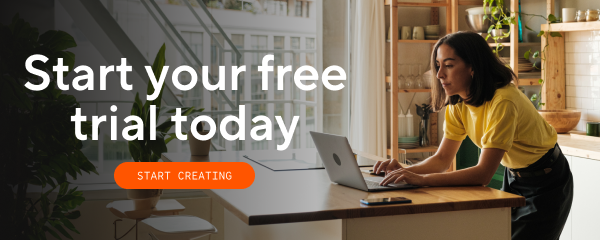There’s one challenge nearly every business owner struggles with at some point, but no one seems to want to do the work to make it happen…
Getting more eyes on your website.
You've spent countless hours (and probably a fair amount of money!) creating a beautiful site that perfectly represents your brand. But if no one's seeing it? Well, that's kind of like having the world's most beautiful store in a ghost town.
The good news? There's a tried-and-true solution to this problem that's been working for years, continues to work today, and shows no signs of slowing down:
Blogging.
And we're not just saying this because we want you to read our blog (though we're thrilled you're here!). We're saying it because the data backs it up.
The Numbers Don't Lie: Blogging = More Traffic
If you're on the fence about whether blogging is worth your time, these statistics might convince you:
⭐ Companies with blogs produce an average of 67% more leads per month than companies that don't have active blogs. (That's according to DemandMetric!)
⭐ Websites with blogs have 434% more indexed pages than websites without blogs. More indexed pages = more chances to show up in search results.
⭐ Businesses that prioritize blogging are 13x more likely to see positive ROI from their marketing efforts.
⭐ 75% of marketers believe that AI-enabled search engines will positively impact their blogs, making them even more valuable assets in the future.
These aren't small improvements we're talking about. These are game-changing numbers that could transform your business's online visibility.
How Blogging Increases Your Website Traffic

So how exactly does blogging work its traffic-building magic? Let's break it down:
1. More Pages = More Opportunities to Be Found
Every time you publish a blog post, you're creating a new page on your website.
Each of these pages can be indexed by search engines, which means each post gives you another opportunity to show up in search results. The more posts you have, the more inbound links you create for someone to reach your website.
It's simple math: if you have 5 pages on your website, you have 5 chances to rank in search engines. If you have 50 pages (thanks to a consistent blogging strategy), you have 50 chances!
And who wouldn’t want more chances for their ideal clients and customers to find them on Google?
2. Fresh Content Signals an Active Site
Search engines LOVE fresh content.
And when you regularly update your blog, you're sending a clear signal to Google that your site is alive and well — signaling to the search engine that “hey, there’s some FRESH new content over here.”
Google prioritizes active websites in search results because they're more likely to provide relevant, up-to-date information to searchers.
Think about it this way:
If you were Google, would you send people to a website that hasn't been updated since 2019, or one that published new content last week? The answer is obvious!
Of course you wouldn’t; it’s your job to give people the best answer to their question — so naturally, if you’re Google, you’re sending them to the page with the best information, which more often than not is the most current page.
3. Blogging Gives People a Reason to Stay Longer
When visitors find valuable blog content on your site, they stick around longer to consume it. This increased “dwell time” is another positive signal to search engines that your site is providing value.
Plus, the longer someone stays on your site, the more likely they are to explore other pages, learn about your services, and eventually convert from a visitor to a client.
4. Each Blog Post Is a Long-Term Traffic Asset
Unlike social media posts that disappear from feeds within hours, blog posts can continue driving traffic to your site for years. We have blog posts from several years ago that still bring in consistent traffic every single month!
This is what we call “compounding returns” on your content investment.
The traffic potential of your blog grows over time as you add more posts, creating a snowball effect that can significantly increase your overall traffic.
5. Blogs Create Shareable Content
A great blog post is something people want to share.
When readers share your content on social media or link to it from their own websites, you gain:
- Exposure to new audiences
- Social proof that your content is valuable
- Backlinks that boost your SEO
- Additional traffic sources beyond search engines
All of these factors combine to create a powerful traffic-generating machine for your business.
How to Start Blogging for Traffic Growth
Now that you understand WHY blogging works so well for increasing website traffic, let's talk about HOW to implement a successful blogging strategy:
1. Focus on Quality Over Quantity
While posting consistently is important, quality always trumps quantity. One exceptional, in-depth post that truly helps your audience will generate more traffic than five rushed, surface-level posts.
Take the time to create content that's:
- Genuinely helpful to your ideal audience
- Well-researched and accurate
- Thoughtfully organized and easy to read
- Written in your authentic voice
Remember: you're not just trying to attract any traffic—you want to attract the RIGHT traffic that consists of your ideal clients and customers.
2. Choose Topics Your Audience Actually Cares About
The most successful blog posts address the questions, challenges, and interests of your target audience. Before you start writing, ask yourself:
- What questions do my clients frequently ask me?
- What problems keep my ideal customer up at night?
- What topics would help my audience achieve their goals?
- What information would make their lives or businesses better?
These questions will help you develop blog topics that resonate with your audience and attract the right kind of traffic to your site.
3. Optimize Your Content for Search Engines
While you should always write for humans first, incorporating SEO best practices will help your blog posts rank higher in search results:
- Include relevant keywords in your titles, headers, and throughout your content (without keyword stuffing!)
- Write compelling meta descriptions that encourage clicks
- Use descriptive URLs that include your target keywords
- Add alt text to images
- Incorporate internal links to other relevant pages on your site
These SEO fundamentals will help search engines understand what your content is about and when to show it to searchers.
4. Be Consistent (But Realistic)
Consistency builds momentum, but be realistic about what you can maintain. It's better to publish one high-quality post per month without fail than to publish four posts one month and then disappear for the next three months.
Create a content calendar that works with your schedule, not against it. Then stick to it!
5. Promote Your Blog Posts
Don't just hit publish and hope for the best. Actively promote your blog posts to help them gain traction:
- Share them on your social media channels
- Include them in your email newsletter
- Repurpose content into different formats (videos, infographics, carousel posts)
- Consider boosting popular posts with a small ad budget
The initial promotion helps your posts gain momentum, which can lead to more shares and links—ultimately increasing your traffic even further.
The Blogging Success Timeline
Here's the thing about blogging for traffic: it's not an overnight strategy. If you're looking for immediate results, paid advertising might be a better fit.
But if you're in it for the long haul (and you should be!), blogging is one of the most cost-effective ways to build sustainable, ongoing traffic to your website.
Here's a realistic timeline of what to expect:
First 3 months: You're laying the foundation. Traffic growth might be minimal, but you're building your content library.
Months 3-6: You start seeing some momentum. Search engines are indexing more of your content, and you might notice increased traffic from long-tail keywords.
Months 6-12: The snowball effect begins. You have enough content that visitors are starting to explore multiple posts, and your overall traffic shows consistent growth.
Beyond 12 months: This is where the magic happens. With a solid body of content that's ranking well, your traffic grows more significantly, and older posts continue to bring in visitors month after month.
Patience and persistence are key. The businesses that stick with blogging consistently are the ones that see the most impressive traffic results.
The 7-Step Process For Blogging Your Way To More Website Traffic
The evidence is clear: blogging works for increasing website traffic.
But like any effective strategy, it requires commitment, quality execution, and a focus on providing real value to your audience.
If you're ready to start your blogging journey (or recommit to a consistent blogging practice), here's your action plan:
- Choose 3-5 topics your audience would love
- Create a realistic publishing schedule
- Write your first post (or plan your next one if you already have a blog)
- Optimize it for search engines
- Publish and promote it
- Track your results
- Repeat!
And the best part? If you're using Showit for your website, adding a blog is super simple with our WordPress integration.
You get all the design flexibility of Showit with the powerful blogging capabilities of WordPress—the perfect combination for building a traffic-generating website.
Give your brand the traffic boost it deserves + start growing your online presence with consistent blogging on your Showit site. Try Showit free for 14 days!


